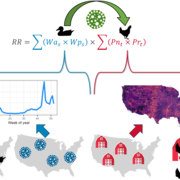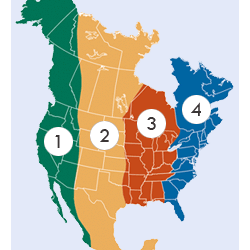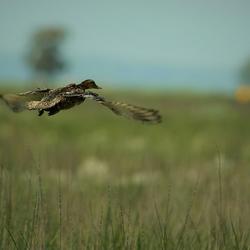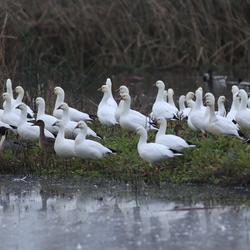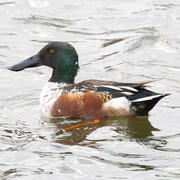Canada Geese using a small retention pond near a commercial poultry facility.
Diann Prosser, Ph.D.
Diann is a research wildlife ecologist at the Eastern Ecological Science Center located in Laurel, MD.
Productivity of Species of Concern – Least Tern and Common Tern on Poplar Island Restoration Site

This project aims to understand the factors driving breeding success of multiple waterbird species, with special emphasis on Least and Common Terns (two species of concern) on Poplar Island Environmental Restoration Project.
She began working at Patuxent in 1999. Her background is in wetland ecology and ornithology and her research interests include using spatial modeling techniques to help answer questions related to wildlife and stressors such as climate change and disease.
Recently Hosted Visiting Scientists from Chinese Academy of Sciences (2012-2013).
Professional Experience
2012 - present Research Wildlife Biologist, USGS Eastern Ecological Science Center, Laurel, MD
2004 - 2012 Wildlife Biologist, USGS Patuxent Wildlife Research Center, Laurel, MD
1998 - 2004 Biological Scientist, USGS Patuxent Wildlife Research Center, Laurel, MD
1993 - 1998 Research Associate, Penn State Cooperative Wetlands Center, State College, PA
Education and Certifications
B.S. in Wildlife and Fisheries Science (1995) from the Pennsylvania State University
M.S. in Ecology (1998) from the Pennsylvania State University
Ph.D. (2012) from the University of Maryland’s Marine Estuarine Environmental Sciences interdisciplinary ecology program
Honors and Awards
2017 Presidential Early Career Award for Scientists and Engineers (PECASE)
University of Maryland Goldhaber Travel Grant
2011 NSF SGER Grant
2007 NSF East Asia and Pacific Summer Institutes
2005 University of Maryland Nagel Travel Grant
2005 USGS, Patuxent Wildlife Research Center Star Award 2000
Science and Products
Advancing Risk Modeling for Highly Pathogenic Avian Influenza
Understanding Circulating Avian Influenza Viruses and How They Spread
Pathogens in the Aquatic Environment – Waterfowl, Avian Influenza
USGS Wild Bird Avian Influenza Program – Studies from Endemic Regions of Eurasia
Avian Influenza Host Movement Ecology
Using Global Telemetry to Understand Avian Movement and Migration
Avian Influenza Viral Pathogenicity
Avian Influenza Spread, Prevalence and Persistence
Identifying Spatial and Temporal Trends in Avian Influenza Prevalence in Wild Waterfowl Across the United States
Deriving Spatial and Temporal Waterfowl Inputs for Disease Risk Modeling
Developing Waterfowl Distribution and Abundance Models to Inform Avian Influenza Transmission Risk
Understanding Avian Influenza Exposure and Antibodies in Understudied Species
Data describing IAV infection and seroprevalence in Lesser and Greater Scaup Data describing IAV infection and seroprevalence in Lesser and Greater Scaup
Data supporting work to understand the impacts of 2.3.4.4b highly pathogenic H5N1 avian influenza virus infection on Snow Goose movement ecology Data supporting work to understand the impacts of 2.3.4.4b highly pathogenic H5N1 avian influenza virus infection on Snow Goose movement ecology
Data supporting a meta-analysis of avian influenza host dynamics Data supporting a meta-analysis of avian influenza host dynamics
Video observations of Common Terns usurping and brooding Least Tern chicks Video observations of Common Terns usurping and brooding Least Tern chicks
Code, input data, and simulated spatiotemporal distributions and energetic profiles for a model of mallard and northern pintail migration across the Northern Hemisphere Code, input data, and simulated spatiotemporal distributions and energetic profiles for a model of mallard and northern pintail migration across the Northern Hemisphere
Data describing the lack of Avian influenza infection and antibodies in Eastern Wild Turkeys (Meleagris gallopavo silvestris) sampled in Delmarva, USA Data describing the lack of Avian influenza infection and antibodies in Eastern Wild Turkeys (Meleagris gallopavo silvestris) sampled in Delmarva, USA
Data exploring the impact of road watering on dust accumulation and monarch distribution on Poplar Island Data exploring the impact of road watering on dust accumulation and monarch distribution on Poplar Island
Data describing the use of a newly identified staging area on Patuxent River Naval Air Station by banded Common Terns Data describing the use of a newly identified staging area on Patuxent River Naval Air Station by banded Common Terns
Results of Virus Isolation and Serology testing on Influenza A Virus Samples from Lesser Scaup (Aythya affinis) and Greater Scaup (Aythya Marila) Results of Virus Isolation and Serology testing on Influenza A Virus Samples from Lesser Scaup (Aythya affinis) and Greater Scaup (Aythya Marila)
Estimates of avian influenza transmission risk across the wild waterfowl - domestic poultry interface (ver. 2.0, May 2024) Estimates of avian influenza transmission risk across the wild waterfowl - domestic poultry interface (ver. 2.0, May 2024)
Data describing highly pathogenic H5N1 in Double-crested Cormorants of the Chesapeake Bay (ver. 2.0, December 2024) Data describing highly pathogenic H5N1 in Double-crested Cormorants of the Chesapeake Bay (ver. 2.0, December 2024)
Timing of Occurrence of Waterfowl in U.S. Counties and Canadian Counties, Boroughs, Census Districts, and Other Populated Area Designations with Modeled Exposure Status to Highly Pathogenic Avian Influenza Virus in 2021-2022 Timing of Occurrence of Waterfowl in U.S. Counties and Canadian Counties, Boroughs, Census Districts, and Other Populated Area Designations with Modeled Exposure Status to Highly Pathogenic Avian Influenza Virus in 2021-2022
Canada Geese using a small retention pond near a commercial poultry facility.
Spring migration departure date (a–e) and duration of first stopover (f–j) by species and infection status across 84 individuals with paired influenza and telemetry data. Partially transparent points show raw data; large points and error bars show means and 95% confidence intervals estimated from linear models.
Spring migration departure date (a–e) and duration of first stopover (f–j) by species and infection status across 84 individuals with paired influenza and telemetry data. Partially transparent points show raw data; large points and error bars show means and 95% confidence intervals estimated from linear models.

Conceptual Diagram of NSF PIPP Avian Influenza work
Conceptual Diagram of NSF PIPP Avian Influenza workThis conceptual diagram explains how the research involved in the NSF PIPP project will be broken down into specific components.
Conceptual Diagram of NSF PIPP Avian Influenza work
Conceptual Diagram of NSF PIPP Avian Influenza workThis conceptual diagram explains how the research involved in the NSF PIPP project will be broken down into specific components.
This bar-headed goose (Anser indicus) was marked with a satellite transmitter at Qinghai Lake, China, in an effort to understand the role that wild birds play in avian influenza.
This bar-headed goose (Anser indicus) was marked with a satellite transmitter at Qinghai Lake, China, in an effort to understand the role that wild birds play in avian influenza.
Rapid increase in antibodies to influenza A virus H5 and N1 in Lesser Scaup (Aythya affinis) following the introduction of 2.3.4.4B H5N1 into North America Rapid increase in antibodies to influenza A virus H5 and N1 in Lesser Scaup (Aythya affinis) following the introduction of 2.3.4.4B H5N1 into North America
Host responses and viral traits interact to shape the impacts of climate warming on highly pathogenic avian influenza in migratory waterfowl Host responses and viral traits interact to shape the impacts of climate warming on highly pathogenic avian influenza in migratory waterfowl
Spatiotemporal overlap of mallards with poultry farms is associated with greater risk of avian influenza wild bird spillover events Spatiotemporal overlap of mallards with poultry farms is associated with greater risk of avian influenza wild bird spillover events
OFFLU guidelines for high pathogenicity avian influenza virus risk mitigation in cattle OFFLU guidelines for high pathogenicity avian influenza virus risk mitigation in cattle
Avian influenza spillover into poultry: Environmental influences and biosecurity protections Avian influenza spillover into poultry: Environmental influences and biosecurity protections
Landscape changes elevate the risk of avian influenza virus diversification and emergence in the East Asian–Australasian Flyway Landscape changes elevate the risk of avian influenza virus diversification and emergence in the East Asian–Australasian Flyway
Density dependence and weather drive dabbling duck spatiotemporal distributions and intercontinental migration Density dependence and weather drive dabbling duck spatiotemporal distributions and intercontinental migration
Potential impacts of 2.3.4.4b highly pathogenic H5N1 avian influenza virus infection on Snow Goose (Anser caerulescens) movement ecology Potential impacts of 2.3.4.4b highly pathogenic H5N1 avian influenza virus infection on Snow Goose (Anser caerulescens) movement ecology
U.S. Geological Survey science strategy to address highly pathogenic avian influenza and its effects on wildlife health 2025–29 U.S. Geological Survey science strategy to address highly pathogenic avian influenza and its effects on wildlife health 2025–29
A practical decision tool for marine bird mortality assessments A practical decision tool for marine bird mortality assessments
Avian influenza infection and antibodies not identified in eastern wild turkeys (Meleagris gallopavo silvestris) sampled on the Delmarva Peninsula Avian influenza infection and antibodies not identified in eastern wild turkeys (Meleagris gallopavo silvestris) sampled on the Delmarva Peninsula
Highly pathogenic avian influenza virus H5N1 in double-crested cormorants (Nannopterum auritum) of the Chesapeake Bay, USA Highly pathogenic avian influenza virus H5N1 in double-crested cormorants (Nannopterum auritum) of the Chesapeake Bay, USA
Visualizing Models for Avian Influenza Viruses Visualizing Models for Avian Influenza Viruses
Avian Influenza: Research by the USGS and Partners Avian Influenza: Research by the USGS and Partners
Story Map: Avian Influenza in the United States Story Map: Avian Influenza in the United States
Risk Modeling at the Wild Waterfowl-Domestic Poultry Interface - Interactive Dashboard Risk Modeling at the Wild Waterfowl-Domestic Poultry Interface - Interactive Dashboard
Science and Products
Advancing Risk Modeling for Highly Pathogenic Avian Influenza
Understanding Circulating Avian Influenza Viruses and How They Spread
Pathogens in the Aquatic Environment – Waterfowl, Avian Influenza
USGS Wild Bird Avian Influenza Program – Studies from Endemic Regions of Eurasia
Avian Influenza Host Movement Ecology
Using Global Telemetry to Understand Avian Movement and Migration
Avian Influenza Viral Pathogenicity
Avian Influenza Spread, Prevalence and Persistence
Identifying Spatial and Temporal Trends in Avian Influenza Prevalence in Wild Waterfowl Across the United States
Deriving Spatial and Temporal Waterfowl Inputs for Disease Risk Modeling
Developing Waterfowl Distribution and Abundance Models to Inform Avian Influenza Transmission Risk
Understanding Avian Influenza Exposure and Antibodies in Understudied Species
Data describing IAV infection and seroprevalence in Lesser and Greater Scaup Data describing IAV infection and seroprevalence in Lesser and Greater Scaup
Data supporting work to understand the impacts of 2.3.4.4b highly pathogenic H5N1 avian influenza virus infection on Snow Goose movement ecology Data supporting work to understand the impacts of 2.3.4.4b highly pathogenic H5N1 avian influenza virus infection on Snow Goose movement ecology
Data supporting a meta-analysis of avian influenza host dynamics Data supporting a meta-analysis of avian influenza host dynamics
Video observations of Common Terns usurping and brooding Least Tern chicks Video observations of Common Terns usurping and brooding Least Tern chicks
Code, input data, and simulated spatiotemporal distributions and energetic profiles for a model of mallard and northern pintail migration across the Northern Hemisphere Code, input data, and simulated spatiotemporal distributions and energetic profiles for a model of mallard and northern pintail migration across the Northern Hemisphere
Data describing the lack of Avian influenza infection and antibodies in Eastern Wild Turkeys (Meleagris gallopavo silvestris) sampled in Delmarva, USA Data describing the lack of Avian influenza infection and antibodies in Eastern Wild Turkeys (Meleagris gallopavo silvestris) sampled in Delmarva, USA
Data exploring the impact of road watering on dust accumulation and monarch distribution on Poplar Island Data exploring the impact of road watering on dust accumulation and monarch distribution on Poplar Island
Data describing the use of a newly identified staging area on Patuxent River Naval Air Station by banded Common Terns Data describing the use of a newly identified staging area on Patuxent River Naval Air Station by banded Common Terns
Results of Virus Isolation and Serology testing on Influenza A Virus Samples from Lesser Scaup (Aythya affinis) and Greater Scaup (Aythya Marila) Results of Virus Isolation and Serology testing on Influenza A Virus Samples from Lesser Scaup (Aythya affinis) and Greater Scaup (Aythya Marila)
Estimates of avian influenza transmission risk across the wild waterfowl - domestic poultry interface (ver. 2.0, May 2024) Estimates of avian influenza transmission risk across the wild waterfowl - domestic poultry interface (ver. 2.0, May 2024)
Data describing highly pathogenic H5N1 in Double-crested Cormorants of the Chesapeake Bay (ver. 2.0, December 2024) Data describing highly pathogenic H5N1 in Double-crested Cormorants of the Chesapeake Bay (ver. 2.0, December 2024)
Timing of Occurrence of Waterfowl in U.S. Counties and Canadian Counties, Boroughs, Census Districts, and Other Populated Area Designations with Modeled Exposure Status to Highly Pathogenic Avian Influenza Virus in 2021-2022 Timing of Occurrence of Waterfowl in U.S. Counties and Canadian Counties, Boroughs, Census Districts, and Other Populated Area Designations with Modeled Exposure Status to Highly Pathogenic Avian Influenza Virus in 2021-2022
Canada Geese using a small retention pond near a commercial poultry facility.
Canada Geese using a small retention pond near a commercial poultry facility.
Spring migration departure date (a–e) and duration of first stopover (f–j) by species and infection status across 84 individuals with paired influenza and telemetry data. Partially transparent points show raw data; large points and error bars show means and 95% confidence intervals estimated from linear models.
Spring migration departure date (a–e) and duration of first stopover (f–j) by species and infection status across 84 individuals with paired influenza and telemetry data. Partially transparent points show raw data; large points and error bars show means and 95% confidence intervals estimated from linear models.

Conceptual Diagram of NSF PIPP Avian Influenza work
Conceptual Diagram of NSF PIPP Avian Influenza workThis conceptual diagram explains how the research involved in the NSF PIPP project will be broken down into specific components.
Conceptual Diagram of NSF PIPP Avian Influenza work
Conceptual Diagram of NSF PIPP Avian Influenza workThis conceptual diagram explains how the research involved in the NSF PIPP project will be broken down into specific components.
This bar-headed goose (Anser indicus) was marked with a satellite transmitter at Qinghai Lake, China, in an effort to understand the role that wild birds play in avian influenza.
This bar-headed goose (Anser indicus) was marked with a satellite transmitter at Qinghai Lake, China, in an effort to understand the role that wild birds play in avian influenza.




